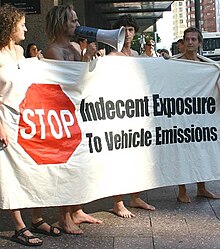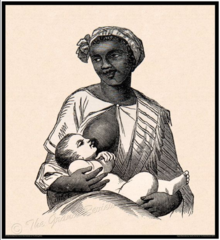Streaking is a type of indecent exposure
Indecent exposure is the deliberate exposure in public or in
view of the general public by a person of a portion or portions of their
body in circumstances where the exposure is contrary to local moral or
other standards of appropriate behavior. The term indecent exposure
is a legal expression. Social and community attitudes to the exposing
of various body parts and laws covering what is referred to as indecent
exposure vary significantly in different countries. It ranges from
outright prohibition to prohibition of exposure of certain body parts,
such as the genital area, buttocks or breasts.
Decency is generally judged by the standards of the local
community, which are seldom codified in specifics in law. Such standards
may be based on religion, morality or tradition, or justified on the
basis of "necessary to public order". Non-sexual exhibitionism or public nudity is sometimes considered indecent exposure. If sexual acts are performed, with or without an element of nudity, this can be considered gross indecency, which is usually a more serious criminal offence. In some countries, exposure of the body in breach of community standards of modesty is also considered to be public indecency.
The legal and community standards of what states of undress
constitute indecent exposure vary considerably and depend on the context
in which the exposure takes place. These standards have also varied
over time, making the definition of indecent exposure a complex topic.
Overview
This section does not cite any sources. (May 2019) (Learn how and when to remove this template message)
|
It is generally accepted, at least in Western countries, that a naked human body is not in itself indecent. That principle is reflected, for example, in depiction of the human form
in art of various forms. Nevertheless, as a general rule, it is also
commonly expected that people when they appear in a public place will be
appropriately attired. Inappropriateness is viewed in context, so that,
for example, what may be appropriate on a beach may be inappropriate in
a street, school or workplace. Depending on the context, some degree of
inappropriateness may be tolerated, and perhaps described as eccentric,
but in extreme cases of inappropriateness it may be regarded as
"crossing the line". Besides the social disapproval of such a state of
dress, most jurisdictions have laws to "maintain social order",
variously described as public nudity, indecent exposure, as an affront to public morality, public nuisance, besides others.
History
What is an inappropriate state of dress in a particular context depends on the standards of decency
of the community where an exposure takes place. These standards vary
from time to time and can vary from the very strict standards of modesty in places such as Afghanistan and Saudi Arabia, which require most of the body to be covered, to tribal societies such as the Pirahã or Mursi where full nakedness is the norm.
There is generally no implication that the state of dress objected to
is of a sexual nature; and if such an allegation were to be made, the
act would generally be described as "gross indecency".
The standards of decency have varied over time. During the Victorian era, for example, exposure of a woman's legs, and to some extent the arms, was considered indecent in much of the Western world.
Hair was sometimes required to be covered in formal occasions as in
the form of a hat or bonnet. As late as the 1930s - and to some extent,
the 1950s - both women and men were expected to bathe or swim in public
places wearing bathing suits that covered above the waist. An adult woman exposing her navel
was also considered indecent in the West into the 1960s and 1970s, and
even as late as the 1980s. Moral values changed drastically during the
1990s and 2000s, which in turn changed the criteria for indecent
exposure. Public exposure of the navel has been accepted during the
1990s, such as in beaches, while in the 2000s, the buttocks can be
exposed while wearing a thong. Today, however, it is quite common for
women to go topless at public beaches throughout Europe and South
America and even some parts of the United States.
Symbolism
Although the phenomenon widely known as flashing, involving a woman exposing bare nipples by suddenly pulling up her shirt and bra,
may be free from sexual motive or intent, it nonetheless is public
exposure and is therefore defined by statute in many states of the
United States as prohibited criminal behavior.
Breastfeeding
Breastfeeding in public does not constitute indecent exposure under the laws of the United States, Canada, Australia, or Scotland. In the United States, the federal government and all 50 states
have enacted laws specifically protecting nursing mothers from
harassment by others. Legislation ranges from simply exempting
breastfeeding from laws regarding indecent exposure, to outright full
protection of the right to nurse.
Public clothing
Public
clothing varies by country and may be regulated by law. What parts of
the body must be covered varies by region. Although genitals are usually
expected to be covered in public in almost all societies, when it comes
to other parts of the body such as female breasts, midriff, legs or
shoulders, norms vary. For example, in some African cultures, it is the
thighs, not the breasts, which must be covered.
In some societies, the head hair, especially female, must be covered,
usually with a scarf. The vast majority of cultures accept that the face
can and must be seen, but some cultures (especially in the Middle East), require that it be covered under a burqa. In conservative societies, appearing in a public place in clothing that is deemed 'indecent' is illegal.
In many countries there are exceptions to the general rules (social or
legal) regarding clothing. For instance, a country which generally
prohibits full nudity may allow it in designated places, such as nude beaches, or during various social events such as festivals or nude protests.
Outraging public decency
Outraging public decency is a common law offence in England and Wales and Hong Kong. It is punishable by unlimited imprisonment and/or an unlimited fine.
The first recorded example of the offence was Sedley's Case (1675) Strange 168, 1 Sid 168 – Sir Charles Sedley was prosecuted for urinating on a crowd from the balcony of Oxford Kate's tavern in Covent Garden.
Modern case law has established two elements that must be satisfied for the offence to have been committed:
- the act was of such a lewd character as to outrage public decency; this element constitutes the nature of the act, which has to be proved before the offence can be established, and
- the act took place in a public place and must have been capable of being seen by two or more persons who were actually present, even if they did not actually see it.
The offence is currently prosecuted around 400–500 times per year in England and Wales.
The foetus earrings case
In December 1987, artist Rick Gibson
exhibited a pair of earrings made with freeze-dried human foetuses at
the Young Unknowns Gallery in London. On 3 December 1987 the earrings
were seized by the police.
On 11 April 1988, Gibson and the gallery owner Peter Sylveire, were formally charged with the common law offences
of exhibiting a public nuisance and outraging public decency. This was
the first occasion on which the charge of outraging public decency had
been preferred in more than 80 years.
The trial started on 30 January 1989. On 6 February 1989 the public nuisance charge was dismissed.
The defence raised a point of law, that "outraging public
decency" was no longer known in law so long after the last occasion on
which the charge had been preferred. The judge ruled that it could still
be preferred no matter how long the hiatus, provided the facts fitted
the offence. On 9 February 1989 the jury found Gibson and Sylveire
guilty of outraging public decency. Gibson was fined £500 and Sylveire
was fined £300.
The defence appealed on the point of the validity of the charge of outraging public decency, which was dismissed by the Court of Appeal, which upheld the trial judge's ruling and went some way to restating the law in this area.
Europe
Attitudes towards nudity vary by country and are generally most relaxed in Scandinavia,
where genitals and breasts are not normally considered indecent or
obscene. Hence, laws and societal views on public nudity are generally
relaxed. In Finland, it is very typical for patrons to bathe nude in the intense heat of saunas.
In the Netherlands, public nudity is allowed at sites that have been assigned by the local authorities and "other suitable places."
On nudist beaches, in unisex saunas and in swimming pool changing
rooms, remaining partially clothed is frowned upon and the social norm
is to undress.
In Barcelona,
public nudity was a recognised right. However, on 30 April 2011, the
Barcelona City Council voted a by-law forbidding walking "naked or
nearly naked in public spaces" and limiting the wearing of bathing
costumes to pools, beaches, adjacent streets and sea-side walks.
Other countries, such as the UK, Ireland or Poland are more conservative.
United Kingdom
Legislation
concerning public nudity varies among the countries of the United
Kingdom. In England and Wales public nudity is not in itself illegal;
the use of the term "indecent exposure" dates back to earlier criminal
law.
England and Wales
In the England and Wales during the 19th and 20th centuries, indecent exposure was prosecuted under either section 28 of the Town Police Clauses Act 1847 or section 4 of the Vagrancy Act 1824.
The latter was a piece of legislation that made it an offence to sleep
rough or beg and contained a provision for the prosecution of:
- every person wilfully openly, lewdly, and obscenely exposing his person in any street, road, or public highway, or in the view thereof, or in any place of public resort, with intent to insult any female...
This provision was repealed by section 66 of the Sexual Offences Act 2003
which replaced the offence of "indecent exposure" and other sexual
offences with legislation that is more specific and explicit.
Current laws apply only to genital exposure with intent to shock those
who do not want to see them. The maximum penalty is two years'
imprisonment, but this is extremely rare as most cases are dealt with by
a fine or through community service. People convicted of exposure contrary to section 66 of the Sexual Offences Act 2003 must sign the Violent and Sex Offender Register if they are sentenced to a term of imprisonment or a community order in excess of 12 months, or if the person they exposed themselves to was aged under 18 years of age.
In the past public nudity in England and Wales could also be punished as "disorderly behaviour" under the Public Order Act 1986, sections 4A and 5.
However, the law was clarified in the spring of 2018 and those sections
are no longer considered to apply to simple public nudity. Guidance
from the Crown Prosecution Service and the College of Policing does not recommend prosecution for public nudity if there is no intent to cause alarm.
Scotland
Under Scots law,
"indecent conduct" in a public place, such as exposing the genitals or
engaging in sexual activity, can constitute the common law offence of public indecency. Stephen Gough,
a man known as the "Naked Rambler" who hiked across Britain wearing
only shoes, was arrested numerous times in Scotland. He was convicted of
the common law offence of breach of the peace and spent time in prison for contempt of court for refusing to wear clothes whilst in court.
Northern Ireland
The Sexual Offences (Northern Ireland) Order 2008 brought the legislation regarding indecent exposure in Northern Ireland into line with that in England and Wales.
United States
Left: In New York City, toplessness in public is allowed. Photo shows topless woman at Dyke March, New York, 2013. Right: Many states in US do not allow public exposure of female nipples. Photo shows a woman at a U.S. beach with her nipples covered with pasties.
The laws governing indecent exposure in the United States vary according to location. In most states public nudity
is illegal. However, in some states it is only illegal if it is
accompanied by an intent to shock, arouse or offend other persons. Some
states permit local governments to set local standards. Most states
exempt breastfeeding mothers from prosecution.
Canada
In Canada, s.173 of the Criminal Code prohibits "indecent acts".
There is no statutory definition in the Code of what constitutes an
indecent act, other than the exposure of the genitals and/or female
nipples for a sexual purpose to anyone under 16 years of age. Thus, the
decision of what states of undress are "indecent", and thereby
unlawful, is left to judges. Judges have held, for example, that nude sunbathing is not indecent. Also, streaking is similarly not regarded as indecent.
Section 174 prohibits nudity if it offends "against public decency or
order" and in view of the public. The courts have found that nude
swimming is not offensive under this definition.
Toplessness is also not an indecent act under s.173. In 1991, Gwen Jacob was arrested for walking in a street in Guelph, Ontario
while topless. She was acquitted in 1996 by the Ontario Court of Appeal
on the basis that the act of being topless is not in itself a sexual
act or indecent.
The case has been referred to in subsequent cases for the proposition
that the mere act of public nudity is not sexual or indecent or an
offense. Since then it is legal for a female to walk topless in public anywhere in Ontario, Canada.
Australia
Protesters gathered outside a courthouse to protest against the arrest of Simon Oosterman (second from left), Auckland's 13 February 2005 WNBR organizer.
In Australia, it is a summary or criminal offence in some States and Territories to expose one's genitals (also referred to as – 'his or her person')
in a public place or in view of a public place. In some jurisdictions
exposure of the genitals alone does not constitute an offence unless
accompanied by an indecent act, indecent behaviour, grossly indecent
behaviour, obscenity,
intention to cause offence or deliberate intention. The applicable law
is different in each jurisdiction and in several jurisdictions the
offence of indecent exposure does not apply.[citation needed]
Penalties vary between jurisdictions and are summarised below. Specific state Acts, are as follows:
- Australian Capital Territory – Crimes Act 1900, section 393 – 'indecent exposure' – penalty 12 months. Under the Nudity Act 1976, the responsible minister may declare a public area where public nudity is permitted.
- New South Wales – Summary Offences Act 1988, section 5 – 'wilful and obscene exposure' – penalty six months.
- Northern Territory – Summary Offences Act, section 50 – 'indecent exposure' – penalty 6 months.
- South Australia – Summary Offences Act 1953, section 23 – 'Indecent behaviour and gross indecency' – penalty three months and six months respectively.
- Queensland – Summary Offences Act 2005 No. 4, section 9 – 'wilful exposure' – penalty 12 months.
- Tasmania – Police Offences Act 1935, section 21 – 'Prohibited behaviour' – penalty 12 months. Police Offences Act 1935, section 14 – 'Public decency' – one penalty unit.
- Victoria – Summary Offences Act 1966, section 19 – 'wilful and obscene exposure' – penalty two years. Under the Nudity (Prescribed Areas) Act 1983 the responsible minister may declare a public area where public nudity is permitted.
- Western Australia – Criminal Code, section 203 – 'Indecent acts in public' – criminal penalty two years. Summary conviction penalty: 9 months and fine of $9,000.
Definition of person
The
laws of New South Wales, the Australian Capital Territory and the
Northern Territory use the term "person", while in the other States the
exposure refers to the genital area. It has been noted that a term such as "exposing one's person" relates back to the United Kingdom Vagrancy Act 1824 and Evans v Ewels (1972) where it was said that the word "person" was a genteel synonym for "penis" or "vulva". However, it has been held that the word "person" in s5 of the (NSW) Summary Offences Act is not limited to "penis" or "vulva". For example, in R v Eyles (1997) the offender was seen masturbating in his front garden and charged with obscene exposure under the NSW Act.
- In the case of both males and females, the parts of the body which are capable of being employed for the purpose of obscene exposure are limited. The concepts of obscenity and exposure in a practical sense restrict the potential operation of the provision. There is a question as to whether there is any further restriction to be found in the word "person". The Crown Advocate has submitted that there may be circumstances in which the exposure of the breasts of a woman is capable of being regarded as obscene, and that it is not difficult to imagine circumstances in which the exposure of a person's buttocks could be obscene.
However –
- It is unnecessary and inappropriate to decide in the present case whether her submissions in that regard are correct. The jurisdiction which this Court is exercising is a jurisdiction confined to determining questions of law which arise in the case before the District Court. No question arises in the present case as to whether there are any circumstances in which the exposure by a female of breasts, or by a female or male of buttocks, could involve a contravention of s5. The prosecution case against the appellant was that he obscenely exposed his penis and other genitals. It is sufficient for resolution of the present case to say that this was capable of constituting exposure of "his person" for the purposes of the proceedings against him.
New Zealand
In
New Zealand, Indecent exposure is considered to be where a person
"intentionally and obscenely exposes any part of his or her genitals".
Otherwise there is no specific law prohibiting nudity in public places,
although lesser charges may apply depending on the behaviour of the
individual in question.
The High Court of New Zealand has upheld a conviction of
disorderly conduct for nudity in the street, because it was not a place
where nudity was known to occur or commonplace. Being nude in the street
is likely to incur a small fine if a complaint is made against the
person, or if the person ignores a police request to cover themselves.
Being prosecuted for nudity on a public beach, or any place where nudity
might be expected, is very unlikely.
Saudi Arabia
Women in Saudi Arabia were required to wear robes and a headscarf when in public although Crown Prince Mohammed bin Salman has said that it is not required. In September 2019, Saudi Arabia issued the public decency law identifying the rules related to the public decency that citizens and tourists should follow in compliance with Saudi law.











